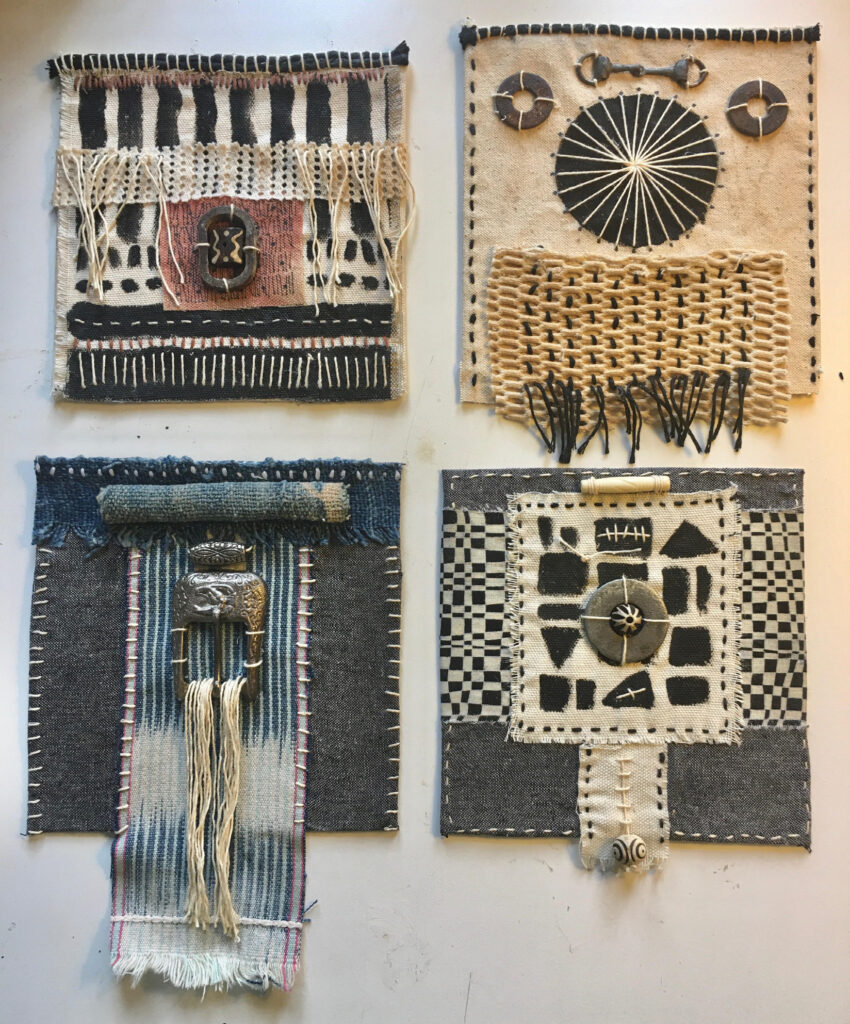
Painter and poet Christine Graf has traversed many artistic pathways to arrive at her latest lyrical mixed media works which are small yet commanding. Her wall pieces are emblematic of sacred spaces in which diverse fragments come together in appealing rhythms of color and form. They are both beautiful to look at and have a calming effect. Graf says she feels a sense of tranquility when creating, adding that the “truest way to work is in pleasing myself and following my intuition.” However, “if I can bring joy and discovery to the viewer, nothing could be more satisfying.”
Professionally trained at the Fashion Institute of Technology in New York and with a long career in commercial design and fabric arts, she worked mainly with surface design patterns. One of her earlier folk art paintings was chosen for the White House. She then began to delve deeply into three dimensionality, experimenting with mixed media, and later with collage, culminating in personal interpretations of Japanese scroll art and calligraphy.
Graf enjoys the research online or in the flea markets, junk shops and auctions. Her latest series was by inspired by studying online art shows, exhibitions and other art resources. The research “creates a spark, and then I begin my journey.” She emphasizes that the latest series is always built on the previous series, “one can see the connection, the linkage.”
In her artist statement, Graf says, “I believe in the Japanese philosophy of wabi sabi; the reverence for the cracked cup, the rusted hammer. So much of what I do is about touch, about the tactile and dimensional.” In her intuitive assembling of disparate fragments––some ephemeral, others weather beaten––her art is a fine example of wabi sabi, revealing beauty in impermanence.
The artist has layered years of life experience in her creativity, expressing both joys and struggles. For a time, while fighting cancer she ceased her mixed media work replacing it with writing. She showed a spontaneous and daring streak, strong self-expression that helped her recover and return to visual art. After such difficulties and now with the current pandemic, she connects with other artists remotely, the happy outcome, selling her work online.
The idea of layering is an important feature of her art making process, where the pieces have small physical parameters, with components glued to a substrate, and a wooden panel box. Graf builds works through a wide variety of graphic and sculptural techniques, repeatedly adhering parts over each other. The works contain collaged elements of fabrics, newspapers, ink gesture drawings, writings, string weavings and diverse found objects combined and creating new mysterious Gestalts. She says, “I find much beauty in discarded objects, salvaged materials which are imbued with meaning and history.”

Graf’s latest pieces, earthy and tribal, are wall hangings of contrasting elements infused with drama through their titles and their final form. A powerful work is “Totem for Resilience” where emotionally charged black gestures are superimposed on the work’s canvas part. In the top section, over black painted strokes, repetitively thick and thin, is a rusted metal spike, askance and corralled by primitively tied netting. On the bottom, a corroded circle dangles behind more netting, coarse strings like thin jail bars as if looking to constrain the battered round form. When all parts are taken together, the work could be seen as an abstract exclamation emphasizing the escape from limitations.
Likewise, her “Totem for Strength” repeats the black gestures, marching down the canvas with three rusted circles placed in a vertical line on the work’s front, like buttons fastening emotions inside shaky-lined textile. The work’s falling strings are thin and drop unevenly from scrolled canvas from the top. The composition, more understated than “Totem for Resilience,” alludes to Japanese calligraphy in which strong emotions underlie economy of expression. Also, the repetitive use of the circle in pieces epitomizes human wholeness and affirms the soul’s immutability. This is evident in the somber “Totem for The Loved and Lost” honoring those tragically felled by the pandemic, Graf places a large circle, resembling a living though damaged flower, floating it above crosses of death, to signify victory of eternal life.
Additionally, two other wall hangings, “Totem for Clean Water,” and “Waterfall,” share compositional affinities with the other works, but are also strong statements demonstrating yearning for a pristine environment, serving as ardent prayers for spiritual protection of the sacred life force.
These inventive pieces possess an overall containment of both the physical and subtle emotions, all of which take on a new form, giving an affirmative shape to more complex emotions and inspiring the viewers to look inward to their own emotions.
Graf says, “It is my intention to bring in the sensual and sensorial to what I create. To remind us of our humanity through the senses.” G&S
The works may be seen at Blue Moon Gallery – etsy.com/shop/ChristineGraf, IG: @ChristineGraf60.





Leave a Comment